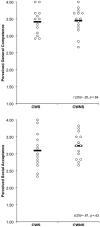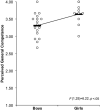Self-perceived competence and social acceptance of young children who stutter: Initial findings
- PMID: 27614314
- PMCID: PMC5125843
- DOI: 10.1016/j.jcomdis.2016.08.004
Self-perceived competence and social acceptance of young children who stutter: Initial findings
Abstract
Purpose: The goals of this study were to determine whether young children who stutter (CWS) perceive their own competence and social acceptance differently than young children who do not stutter (CWNS), and to identify the predictors of perceived competence and social acceptance in young speakers.
Method: We administered the Pictorial Scale of Perceived Competence and Social Acceptance for Young Children (PSPCSA; Harter & Pike, 1984) to 13 CWS and 14 CWNS and examined group differences. We also collected information on the children's genders, temperaments, stuttering frequencies, language abilities, and phonological skills to identify which of these factors predicted PSPCSA scores.
Results: CWS, as a group, did not differ from CWNS in their perceived general competence or social acceptance. Gender predicted scores of perceived general competence, and stuttering frequency predicted perceived social acceptance. Temperament, language abilities, and phonological skills were not significant predictors of perceived competence or social acceptance in our sample.
Conclusions: While CWS did not significantly differ from CWNS in terms of perceived competence and social acceptance, when both talker groups were considered together, girls self-reported greater perceived competence than boys. Further, lower stuttering frequency was associated with greater perceived social acceptance. These preliminary findings provide motivation for further empirical study of the psychosocial components of childhood stuttering.
Learning outcomes: Readers will be able to describe the constructs of perceived competence and social acceptance in young children, and whether early stuttering plays a role in the development of these constructs.
Keywords: Children; Perceived competence; Perceived social acceptance; Self-concept; Stuttering.
Copyright © 2016 Elsevier Inc. All rights reserved.
Figures



Similar articles
-
Speech disfluencies of preschool-age children who do and do not stutter.J Commun Disord. 2014 May-Jun;49:25-41. doi: 10.1016/j.jcomdis.2014.01.003. Epub 2014 Jan 19. J Commun Disord. 2014. PMID: 24503151 Free PMC article.
-
Relationships among linguistic processing speed, phonological working memory, and attention in children who stutter.J Fluency Disord. 2010 Sep;35(3):216-34. doi: 10.1016/j.jfludis.2010.04.003. Epub 2010 May 6. J Fluency Disord. 2010. PMID: 20831969 Free PMC article.
-
Influence of stuttering variation on talker group classification in preschool children: preliminary findings.J Commun Disord. 2009 May-Jun;42(3):195-210. doi: 10.1016/j.jcomdis.2008.12.001. Epub 2008 Dec 24. J Commun Disord. 2009. PMID: 19167719 Free PMC article.
-
Communication attitudes in children who stutter: A meta-analytic review.J Fluency Disord. 2015 Dec;46:1-14. doi: 10.1016/j.jfludis.2015.08.001. Epub 2015 Sep 2. J Fluency Disord. 2015. PMID: 26365773 Review.
-
Stuttering in relation to anxiety, temperament, and personality: review and analysis with focus on causality.J Fluency Disord. 2014 Jun;40:5-21. doi: 10.1016/j.jfludis.2014.01.004. Epub 2014 Feb 8. J Fluency Disord. 2014. PMID: 24929463 Review.
Cited by
-
Self-perception in Children Aged 3 to 7 Years With Amblyopia and Its Association With Deficits in Vision and Fine Motor Skills.JAMA Ophthalmol. 2019 May 1;137(5):499-506. doi: 10.1001/jamaophthalmol.2018.7075. JAMA Ophthalmol. 2019. PMID: 30763432 Free PMC article.
-
Associations of Eye-Related Quality of Life With Vision, Visuomotor Function, and Self-Perception in Children With Strabismus and Anisometropia.Invest Ophthalmol Vis Sci. 2020 Sep 1;61(11):22. doi: 10.1167/iovs.61.11.22. Invest Ophthalmol Vis Sci. 2020. PMID: 32926105 Free PMC article.
References
-
- Ambrose NG, Yairi E. The development of awareness of stuttering in preschool children. Journal of Fluency Disorders. 1994;19:229–245.
-
- Adams PJ, Anderson PL. The relationship of five-year-olds’ academic readiness and perceptions of competence and acceptance. The Journal of Educational Research. 1985;79(2):114–118.
-
- Bajaj A, Hodson B, Westby C. Communicative ability conception among children who stutter and their fluent peers: A qualitative exploration. Journal of Fluency Disorders. 2005;30(1):41–64. - PubMed
-
- Berninger VW, Nielsen KH, Abbott RD, Wijsman E, Rasking W. Gender differences in severity of writing and reading disabilities. Journal of School Psychology. 2008;46:151–172. - PubMed
-
- Blood GW, Blood IM. Bullying in adolescents who stutter: Communicative competence and self-esteem. Contemporary Issues in Communication Science and Disorders. 2004;31:69–79.
MeSH terms
Grants and funding
LinkOut - more resources
Full Text Sources
Other Literature Sources
Medical

